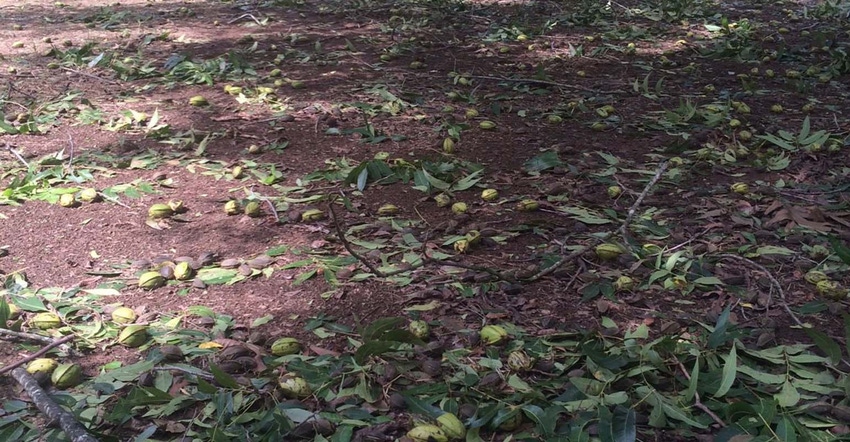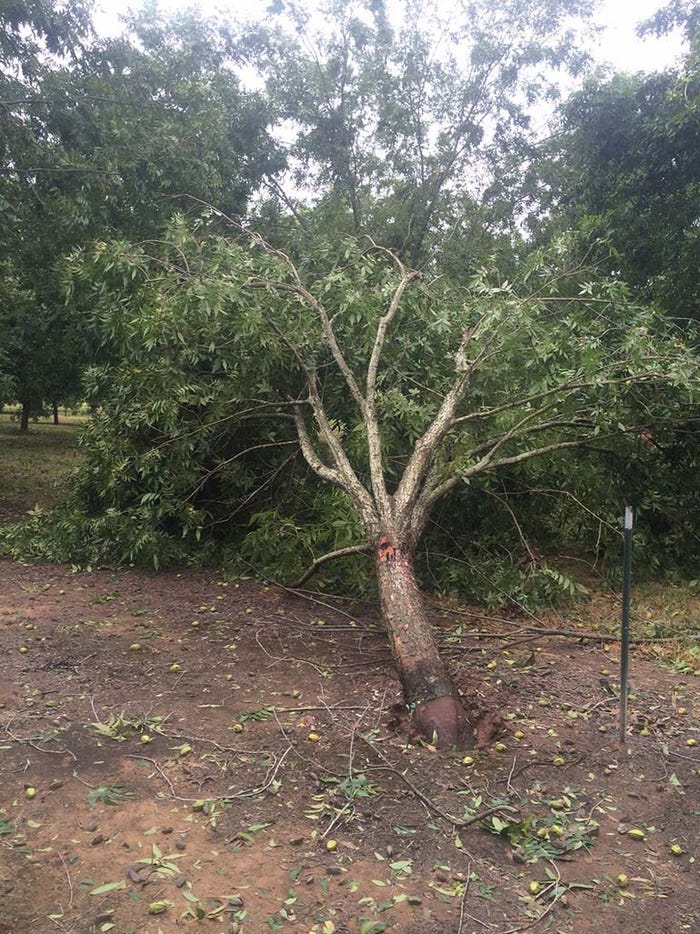
by Megan Durisin
Hurricane Irma’s come and gone, but her aftermath will continue to upend millions of lives and even put Thanksgiving pies at risk.
The storm tore through pecan orchards in Georgia, the No. 1 U.S. grower, just a few weeks before the crop is usually harvested. As much as 30% of production may have been lost after high winds sent pods flying off branches and blew down trees that in some cases measure several stories high, said Lenny Wells, a professor and pecan specialist at University of Georgia in Tifton.
At Lamar Pecan Co. in Hawkinsville, the strong gusts toppled 920 trees, out of about 25,000. Close to a fifth of the operation’s crop may be lost, said R.G. Lamar, whose father and grandfather started the farm about four decades ago. He spent the day after the storm surveying damage in 40 orchards across six counties. It’s the most trees ever lost in one storm, and many that blew over were younger plants less than 15 years old.
“I was heartbroken,” Lamar said. “You work so hard to try to keep the orchards in good repair. I’ve seen wind that strong, but never sustained for that much time.”
While pecans are a niche crop -- the nuts are often associated with holiday desserts -- they’re among Georgia’s top agricultural commodities. National farm prices were already at the highest on record, averaging $2.59 a pound in the marketing year that ended in August 2016, the latest government data show. The gains came amid a surge in demand for U.S. exports in the past decade. Supply damage from Irma could spell even pricier pies for Thanksgiving feasters, who will celebrate the American holiday on Nov. 23 this year.

Hurricane Irma tore through pecan orchards in Georgia, the No. 1 U.S. grower, just a few weeks before the crop is usually harvested
Lasting Damage
Georgia accounts for 30% to 40% of national output, and nearly all of the state’s orchards were affected by the hurricane, said Samantha McLeod, executive director of the Georgia Pecan Growers Association. Additional damage could occur from bruising on nuts that were knocked around by the wind, Christine Lensing, a senior economist at Greenwood Village, Colorado-based CoBank, said in an email. The storm may also trim output in the coming year because of the long-lasting damage to trees.
After slamming into Florida on Sept. 10, Irma’s wrath headed north to Georgia, bringing sustained winds of 20 to 40 miles per hour with gusts as high as 75 (120 kilometers), according to University of Georgia Extension. That made it “the most damaging wind event ever seen by the Georgia pecan industry,” the university group said in statement on its website.
“This storm, it’s like it was targeting pecan orchards,” said Jeb Barrow, the president of the Georgia growers group who also farms about 1,100 acres of the nuts in Jefferson and Burke counties. At his operation, about 400 trees were uprooted and expected yields of about 1,500 pounds an acre may drop by 300 pounds. Hurricanes don’t often blow far enough inland to cause this much damage to the state’s crops, he said.
Pecan trees can produce for decades. Some in the state are 100 years old. Many of the nuts flung to the ground this week are too young to be salvaged. To compound the problem, any new trees planted won’t bear a crop for about five to seven years.

Georgia accounts for 30% to 40% of national output, and nearly all of the state’s orchards were affected by the hurricane, said Samantha McLeod, executive director of the Georgia Pecan Growers Association.
‘Logging Yard’
“It looks like a logging yard,” Trent Mason said of the orchards at Fort Valley-based Mason Pecans, which lost between 3,000 and 4,000 trees on the farm’s 3,000 acres, where he’s a partner. “All you see is just tree after tree laid over. We’ll clean up and harvest what’s left.”
Last year, U.S. pecan farmers grew 269 million pounds (122,000 metric tons) of the nuts, the most in four years, according to U.S. Department of Agriculture data. More than half of Georgia’s pecans are shipped overseas, McLeod of the growers group said.
Luckily for pie lovers, frozen stockpiles of the nut at the end of July were higher than a year earlier, which can cushion supply damage. Production from Texas and New Mexico -- the other leading U.S. producers -- can also help to offset losses from Irma. USDA typically makes an estimate of national output in October.
Several of the Georgia’s other signature crops have also been pummeled this season. As much as 80% of its blueberries and two-thirds of peaches were lost in a March freeze.
“We were poised for a very productive season, but now it will approach devastation for many of our growers,” said Gary Black, Georgia’s agriculture commissioner. “We’re going to have very far-reaching effects in the pecan industry.”
To contact the reporter on this story: Megan Durisin in Chicago at [email protected]
To contact the editors responsible for this story: Simon Casey at [email protected]
Millie Munshi
© 2017 Bloomberg L.P
About the Author(s)
You May Also Like




